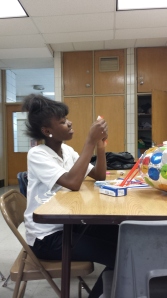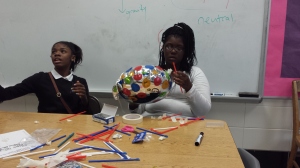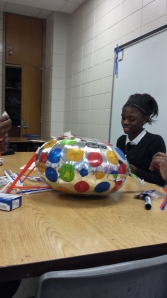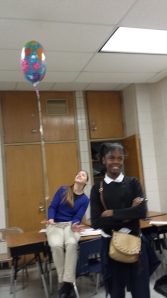Last week at Sisters4Science at Reavis, the Sisters learned about buoyancy, and had some fun with helium balloons!
First, we talked about forces on earth and in space. The girls knew that there was no air in space, and no gravity either. This means that if we were in space, we would just float away! If there’s gravity here on earth, then how does a balloon stay floating in the air? Kemonte answered that balloons have helium in them, and we discussed how helium is less dense than air, and the difference between the two densities pushes the balloon up with a force called “buoyancy.” Since gravity pushes balloons down, and buoyancy pushes them up, we wanted to see how we could make the forces exactly equal, so that the balloon stays floating in the middle of the room, without floating all the way up to the ceiling or sinking all the way down to the floor–this is called making the balloon “neutrally buoyant.”
So, the girls experimented! We had tape, paperclips, and straws, and just about anything in the room that they wanted to use (like markers and paper). Each Sister tried taping and attaching different objects to the balloon in different ways to try to make it neutrally buoyant. Halfway through, Mahogany discovered that where you put an object on the balloon matters just as much as which object you use–she noticed that if you put even a small paperclip right in the center of the balloon, it would sink right away, whereas if you put the same paperclip around the edges or on the string, the balloon would float.
Finally, Kemonte got her balloon to float right in the middle of the room–neutrally buoyant! One minute later, Aaliyah and Mahogany got their balloon to be neutrally buoyant too! It was interesting to see the two different designs, and how each Sister took a different path to achieve the same result.
At the end, each Sister wrote in her journal about why she thinks she earned the Investigation badge–for identifying the research question, designing an experiment, and being able to explain how the experiment set-up helps answer the question. Congrats on getting your Discover Investigation badges, Sisters!




